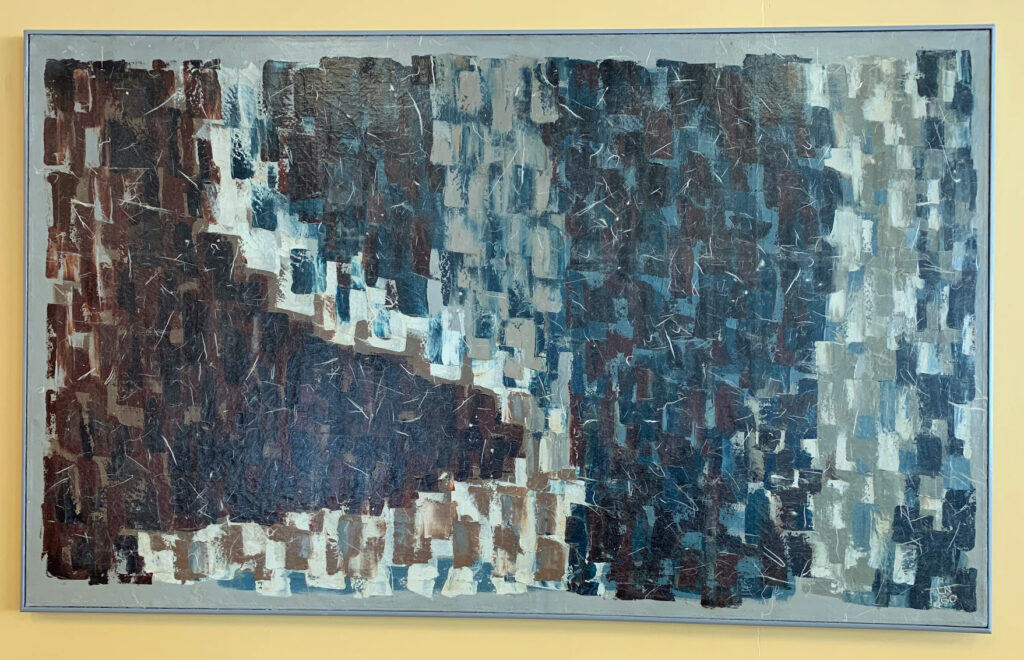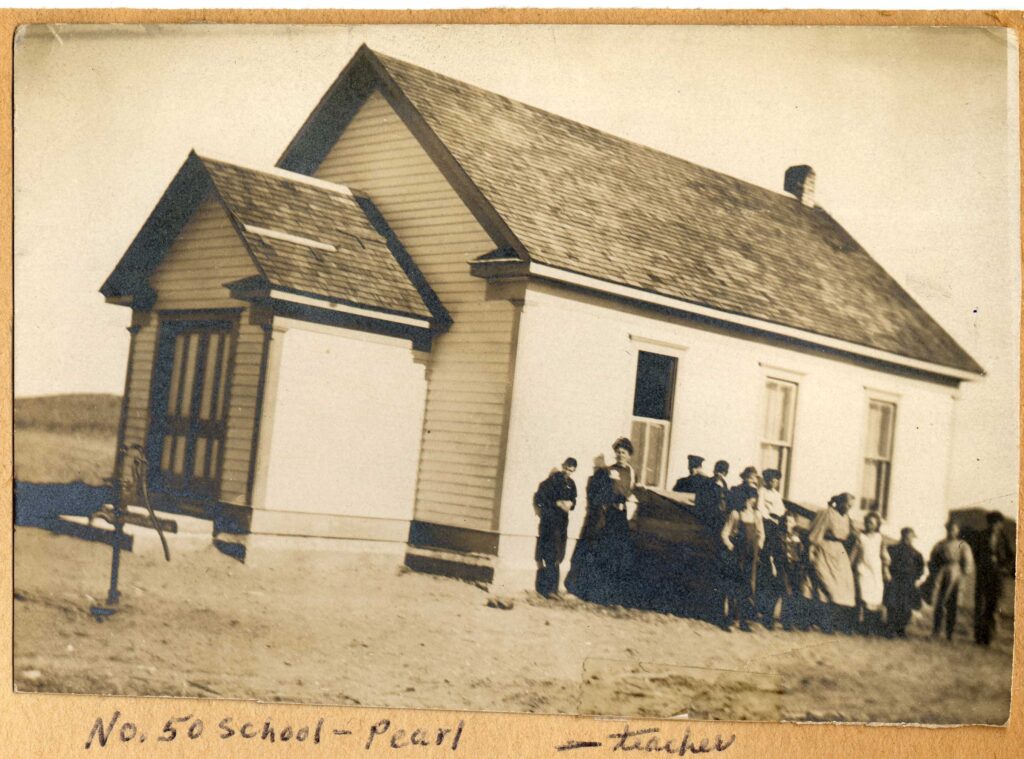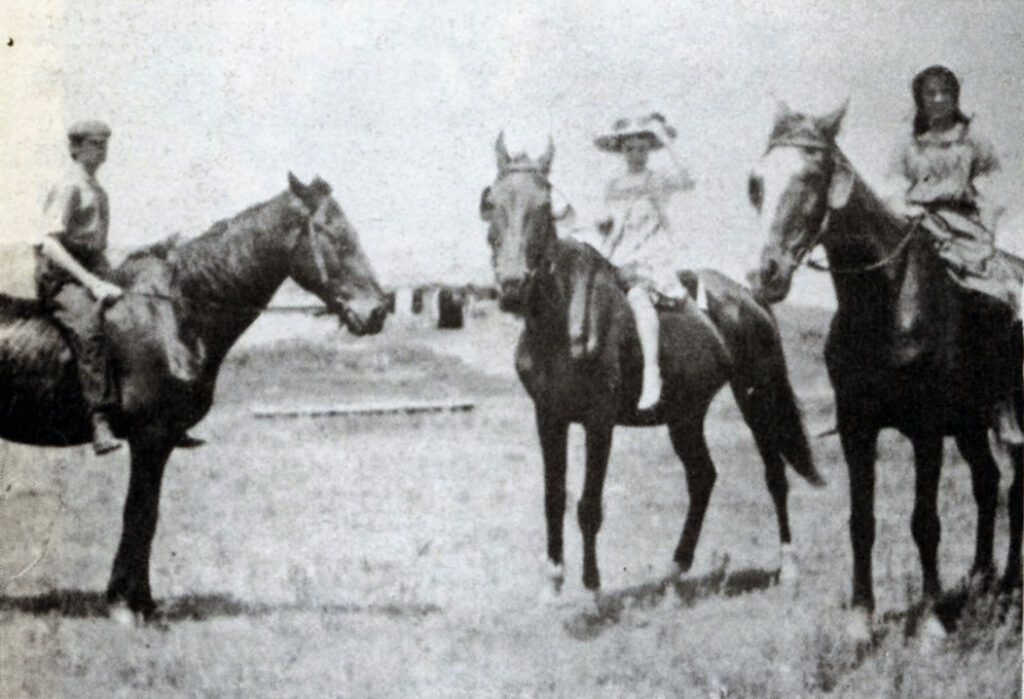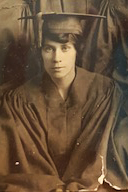
When you come up to the circulation desk of the library, you will notice a large abstract painting above the door to the children’s room. It was a gift to the library from the artist, Leah Williams Nolan, during the 1973 Edwards County Centennial celebration.
Leah Nolan shipped the painting from New York City to library director Beverly Craft. She wrote this description of it. “The painting is the third of a series of five I titled ‘Aggregate No. I’, etc. If I gave it a sub-title it would be ‘Flight of Pigeons’ because it has the rhythm and some other characteristics of the daily exercise flight of the racing pigeons which must be one of the last remaining flocks in the city. They fly just a block away from my kitchen window, and I used to see three or four other flocks in the area when I moved here 22 years ago.”
Leah Williams was born in Kinsley on February 3, 1901 to James E. and Isabel Alexander Williams. Her maternal grandparents, John and Harriet Alexander, had homesteaded northwest of Kinsley on the Dry Route of the Santa Fe Trail. Her mother, Isabelle, was just 4 years old when they arrived in 1878. Her childhood was filled with the excitement of wagon trains, Indians, and the wild and beautiful prairie. Isabel would become a teacher.
Leah’s father James had come to Kinsley from a family farm in Illinois in 1894 to join his brother Samuel F. who grew watermelons and had political ambitions. The brothers were related to the Pierce and Malin families in Lewis. Jim set up a blacksmith shop.
Isabelle (age 22) and James E. (age 31) were married on May 18, 1896. They would have three children: Alfred A. (born 1897), Juanita (born 1898) and Leah. In September 1906, the Williams moved to one of the last available claims in the sand hills 12 miles southwest of Kinsley and close to the Arkansas River.
Five-year old Leah remembered, “Coming for the first time to the claim with my family, arriving in the dark at the end of the day. The howling of coyotes in the distance growing louder as we approached the cabin.”
The family first lived in that one-room cabin until her father built a two-story house. The cabin then became a temporary classroom that Isabelle taught in and a workshop for James.
A proper school house, Sandhill School, District 50, was built in 1908 at the corner of present day V Road and 60th Avenue. Isabelle became superintendent and John Wire’s Aunt Pearl, was hired as the first teacher. By 1912 there were 40 pupils attending.

I was drawn to Leah Williams Nolan not only because of the painting in the library, but also because I enjoy picturing the early days of living in the sand hills as my home is on the northern edge. Leah’s niece, Marybelle Bowman, shared Leah’s memories of her childhood in an article in the Spring 1976 issue of the Kansas Quarterly. Her first memory is:
“Walking on sand, climbing hills and slipping in sand, finding the bald hills south of our place, playing with whole hills of sand, blown out so deeply by the wind that in places, when we dug our fingers a few inches into it, we found water.”
Leah lists memories about stars framed by the hills and “being awakened at three o’clock in the morning – led by the hand to the top of the west hill to look at Halley’s Comet, which filled the sky.”
She remembers going on long rides to pick sand hill plums and “racing horseback, and day-long rides with friends, stopping at windmills for tin cups of cold water.”

She describes listening to her mother and father singing, watching her father making violins and carving gun stocks with intricate designs, and visiting the forge in Kinsley to see him heating iron and shaping it.
In April, 1910 tragedy struck the family with the sudden death of Isabel from pneumonia at age 36. Her sister, Maud Alexander, was a nurse and was called from Colorado to be with her, but she would not recover. Leah ends her memories in the Kansas Quarterly article with:
“In the spring of 1910 a trip to our grandparents’ farm was to take our mother, who was ill and needed special care…. A few days later our aunt came into the room where my sister and I were sleeping and told us our mother had died during the night…. Grief, and premonition that this was the end of thinking as a child, from now on I would have to be responsible for myself, so far as possible…. Our father’s silent grief…. The closeness and sympathy of family and friends…. The sadness of our return to the hills…. The months of trying to continue living there…. The final leaving and the beginning of a different life.”

The Williams family moved into Kinsley. Leah proved to be smart, creative, and popular. She graduated as valedictorian from Kinsley High School in 1918. Next week, I’ll tell you about this sand hill girl’s journey to becoming a successful New York artist.
Leah Williams, valedictorian of the Kinsley High School class of 1918. (Edwards County Museum)
You can access the Kansas Quarterly article with all of Leah’s sand hill memories with this link.
https://drive.google.com/file/d/1QcvR2G9gqBRn4x1OYnGPFEmpmyirLUJi/view?usp=sharing
